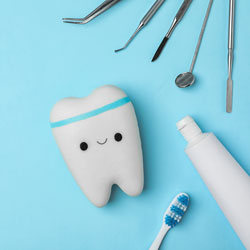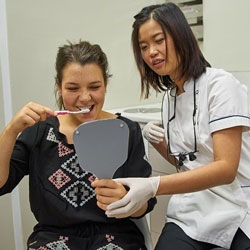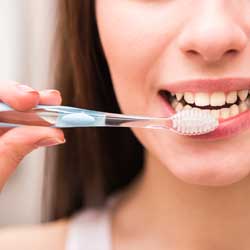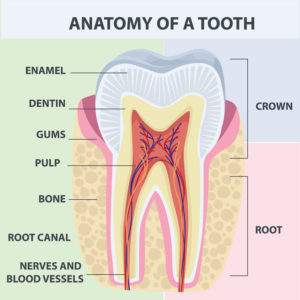8 Fun Dental Facts About Teeth That You Might Not Know

We know that brushing and flossing daily makes for healthy teeth, but do you know these 8 fun facts about your pearly whites?
8 Tooth Facts You May Not Know
1. Tooth enamel is the hardest part of your entire body
 Tooth enamel is the hard shiny top layer of your tooth. Acting like a coat of armour, it protects against nasty bacteria that caBeen a while since you checked your teeth? Book online today >use tooth decay. Tooth enamel is considered the hardest mineral substance in your body. It’s even stronger than bone!
Tooth enamel is the hard shiny top layer of your tooth. Acting like a coat of armour, it protects against nasty bacteria that caBeen a while since you checked your teeth? Book online today >use tooth decay. Tooth enamel is considered the hardest mineral substance in your body. It’s even stronger than bone!
Despite its toughness, we still need to look after our tooth enamel. Tooth enamel can be eroded away by brushing too hard or overexposing teeth to acidity (think lemons or vinegar). Once eroded, tooth enamel is gone permanently.
But luckily, healthy tooth enamel is easy. Here’s 3 simple ways to prevent enamel erosion >
2. Unlike bones, teeth can’t heal themselves
The top tooth enamel coat is not a living tissue, and cannot repair itself.
Humans only get two sets of teeth in a lifetime; baby and adult teeth. If an adult tooth breaks, we cannot grow or regenerate the tooth. Instead, we need to use treatments like crowns or fillings to replace the broken tooth.
For healthy teeth, that’s why we think “prevention is better than a cure” at Whitehorse Dental.
3. Teeth can tell your personal history
 Our daily life leaves a mark on our teeth. Factors like our age, what we eat or drink, or even periods of stress or illnesses leave behind significant clues on our teeth.
Our daily life leaves a mark on our teeth. Factors like our age, what we eat or drink, or even periods of stress or illnesses leave behind significant clues on our teeth.
In this way, dentists are a bit like detectives! We can spot early signs of underlying issues, even before there are any obvious symptoms.
For this reason, we like to see our patients for regular Check-Up & Cleans, every 6-12 months.
4. The human mouth is home to over 6 million bacterias
Over 700 different species of bacteria reside in the human mouth. Some are good and some are bad for your health.
Good oral hygiene keeps the “bacterial load” of bad bacteria low. This, in turn, optimises your immune system since it doesn’t have to work overtime to fight these in-mouth nasties.
To demonstrate, one British study explores how healthy teeth can reduce the severity of COVID-19 symptoms.
5. Healthy teeth are naturally off-white
Unlike what we see on TV or in movies, healthy teeth are not bright white. Instead, our teeth are naturally an off-white colour. Dentine, the layer underneath tooth enamel, is yellow.
If your teeth appear yellow, your tooth enamel may be eroding away and exposing the yellow dentine layer. This is a serious issue so it’s best to book in at the dentist rather than reaching for a teeth whitening kit. Further eroding the enamel will make teeth look yellower, permanently.
For healthy teeth that are discoloured, there are safe and effective ways to whiten them up again. Either way, it’s best to talk to your dentist first. This simple step can save you a lifetime of teeth damage.
Improve your smile safely at our dental clinic in Blackburn >
6. Each tooth is unique
Your teeth are not only unique to you, but each tooth in your mouth has its own unique profile, shape, and size. Every time you smile, you are showing your true individuality!
7. If you don’t brush BETWEEN your teeth, you miss cleaning around 35% of your tooth’s surface
 While your toothbrush does a great job cleaning your teeth, it doesn’t reach between the gaps of your teeth. To effectively clean between teeth, use an interdental brush or floss.
While your toothbrush does a great job cleaning your teeth, it doesn’t reach between the gaps of your teeth. To effectively clean between teeth, use an interdental brush or floss.
We like interdental brushes because we find them easier to use than floss.
For most people, we don’t recommend using Waterpiks or Air Flossers to clean between teeth. Find out why>
8. Teeth are like icebergs, you can only see one-third of your tooth (the other two-thirds is hidden under your gums!)
Unfortunately, this means that teeth problems occurring underneath your gums are hard to notice. Issues like gum disease may not show any obvious signs.
For this reason, a dental x-ray every two years is a vital part of preventative care. Without an x-ray, a lot of crucial information about what’s going on under your gums will be missed. This can lead to a number of dental diseases such as gum infections, cavities, and tooth decay.
Been a while since you checked your teeth? Book online today >


